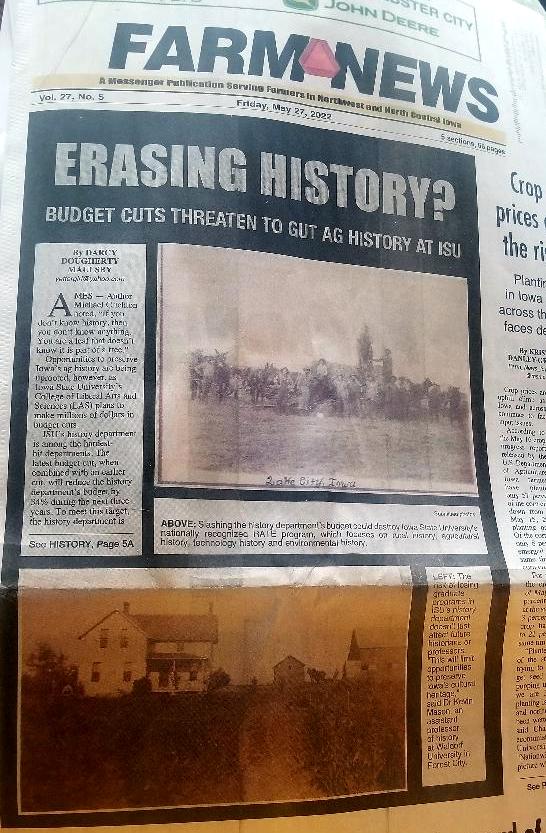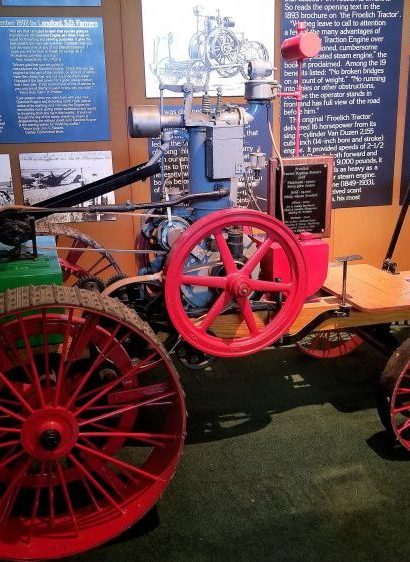
Whats HOT
Latest Posts
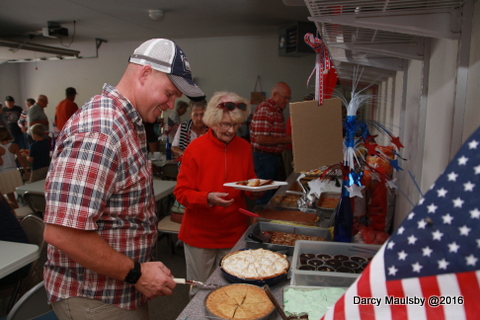
62 Years and Counting: Calhoun County, Iowa, Families Maintain 4th of July Picnic Tradition
Looking for deli fried chicken, bakery pies or other pre-made convenience food? Don’t be surprised if none of it turns up on the massive buffet on the Dial farm during the annual 4th of July picnic. I certainly didn’t see it at this year’s celebration.
“Everyone brings their A game to this event,” said Jolene Schleisman of Lake City, Iowa, who has been attending the 4th of July picnic since she was a child.
While my family has been attending the picnic each July for a few years, the event started in 1954 on Bud Burley’s farm near Lake City. Mike and Dorothy Nichols hosted the party the next year and maintained the tradition until 1981. Then their neighbors, Gerald and Alice Ann Dial, began hosting the celebration on their farm northwest of Lake City. In 2003, the event moved to the Dial’s son Dwight’s farm east of Lake City.
The celebration has been going strong ever since, attracting up to 50 or 60 guests each 4th of July. Along with the fireworks at dusk, the big attraction is the food. Countertops spanning the width of Dial’s two-car garage, along with additional tables, are loaded with homemade fried chicken, roast pork, casseroles, cheese potatoes, baked beans, salads of all kinds, deviled eggs, cakes, pies, candies and more.
“I appreciate how neighbors of all ages enjoy each other’s company,” said Laura Holm, a teacher from Ames who grew up on a farm near Lake City and brings her family back home for the picnic. “I also love the homemade, made-from-the-heart food that comes from friends’ kitchens, not store shelves. This party is about my roots, and I love to teach my kids about these roots.”
At this year’s celebration, Dial’s son, Andy, prepared a number of favorite recipes in honor of his late grandmother, Alice Ann Dial, including her famous lemon me
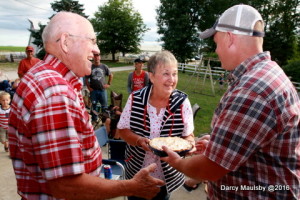
Andy Dial presents a lemon meringue pie to Jim and Joy Angove on their 50th wedding anniversary.
ringue pie. Schleisman also brought a number of classic dishes, including glazed ham balls. Oh yeah, that amazing Iowa classic that makes any picnic a little more memorable.
“To me and the Dial kids, the 4th of July picnic was better than Christmas,” Schleisman said. “I love it that this tradition continues.”
I couldn’t have said it better. Let’s eat!
Savor more Iowa food history
Want more fun Iowa food stories and recipes? Check out my top-selling “Culinary History of Iowa” book from The History Press, and order your signed copy today.
Fried Chicken
Andy Dial used his Grandma Alice Ann Dial’s recipe and his Grandma Dottie Loeck’s cast-iron skillet to make this fried chicken, which is always a star of the 4th of July picnic.
4 dozen chicken hind quarters separated into legs and thighs.
Breading:
5 cups all-purpose flour
1 1 / 2 teaspoons onion powder
1 cup whole wheat flour
1 tsp black pepper
4 tablespoons garlic salt
1 teaspoon paprika
2 tablespoons Lawry’s seasoning salt
Wash:
4 eggs
1 cup whole milk
Combine breading ingredients until mixed thoroughly. Place breading mix into a 9.5-inch pie pan. Beat eggs and milk together until mixed thoroughly. Place egg wash in a separate 9.5-inch pie pan.
Place chicken pieces first in the egg wash until liberally coated; then transfer to the breading mix and turn until coated fully. Once coated with breading, place chicken pieces into hot oil in frying pan. (Andy Dial prefers a cast-iron skillet.) Turn pieces ever 2 to 3 minutes until golden brown all over. Place into roaster pan at 350 degrees to finish cooking through and keep warm until serving time.
Note: To keep chicken crispy, serve immediately after frying.

Glazed Ham Balls are an Iowa classic!
Glazed Ham Balls
Jolene Schleisman of Lake City uses 4 pounds of a ham-ball mix from the locker in Lake City to make these tasty ham balls. Her recipe shows how to make your own ham-ball meat mix, however. These ham balls can be made ahead and frozen (unglazed) to be baked later.
For the ham balls:
2 1 / 2 pounds ground ham
1 1 / 2 pounds ground pork
2 cups instant oatmeal or cracker crumbs
2 eggs, well beaten
1 cup milk
1 teaspoon ground pepper
For the glaze:
1 1 / 2 cups brown sugar
1 / 2 cup apple cider vinegar
1 teaspoon dry mustard
1 / 3 cup Cookies BBQ Sauce
1 / 2 cup water
2 tablespoons honey
Combine ground ham, ground pork, oatmeal or cracker crumbs, eggs, milk and pepper. Shape mixture into balls. Freeze the ham balls to bake later, or place them in a greased, glass baking dish.
To make the glaze, combine brown sugar, apple cider vinegar, dry mustard, BBQ sauce, water and honey in a saucepan. Cook over medium heat until sugar dissolves.
Pour glaze over ham balls. Bake for 1.5 to 2 hours at 275 or 300 degrees. About every 20 minutes, spoon the glaze over the ham balls as they bake. Yield: 32 ham balls
Deviled Eggs
Andy Dial used a recipe from his mother, Jane, to create this potluck favorite.
6 eggs
1 / 16 teaspoon pepper
2 tablespoons mayonnaise
1 / 4 teaspoon paprika
1 teaspoon vinegar
1 / 2 teaspoon dry mustard or 1 teaspoon prepared mustard
1 / 2 teaspoon salt
Slice hard-boiled eggs in half lengthwise. Remove yolks, smash and mix with seasonings. Refill egg whites with seasoned yolk mixture.
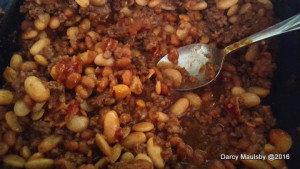
Calico Beans are healthy and always a hit at Iowa picnics.
Calico Beans
Jeanne Devine of Lake City brought along this potluck classic, which she created from a recipe on the Taste of Home website. This recipe can be easily doubled for a larger group.
4 ounces bacon, diced
1 pound lean ground beef (90% lean)
1 / 2 cup chopped onion
1 can (21 ounces) pork and beans
1 can (16 ounces) kidney beans, rinsed and drained
1 can (16 ounces) butter beans, rinsed and drained
1 / 2 cup packed brown sugar
1 / 2 cup ketchup
1 tablespoon cider vinegar
1 teaspoon prepared mustard
1 teaspoon salt
In a large skillet, cook bacon over medium heat until crisp. Remove to paper towels to drain. Discard drippings. In the same skillet, cook beef and onion over medium heat until the meat is no longer pink; drain. Combine the beef mixture, bacon, beans, brown sugar, ketchup, vinegar, mustard and salt. Spoon into a greased 2-quart baking dish.
Bake, uncovered, at 325 degrees for 45 to 60 minutes or until the beans are as thick as desired. Yield: 8-10 servings.
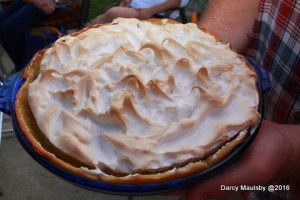
This homemade pie was inspired by Alice Ann Dial’s famous Lemon Meringue Pie.
Lemon Pie
Alice Ann Dial’s signature pie is distinguished by its fresh lemon flavor.
For the filling:
2 cups sugar
4 egg yolks
2 cups water
1 / 2 cup cornstarch
Dash of salt
8 tablespoons fresh lemon juice
2 tablespoons butter
For the meringue:
4 egg whites
8 tablespoons sugar
1 / 4 teaspoon cream of tartar
To mix the pie filling: Blend sugar, egg yolks, water, cornstarch and salt. Cook until the mixture thickens and bubbles up. Remove from heat and add lemon juice and butter. Pour the filling in a pre-baked pie shell made from Alice Ann’s all-purpose pastry mix (see recipe below) and cover immediately with meringue.
To make the meringue, beat the eggs whites until foamy. Add sugar and cream of tartar. Beat slowly until peaks form. Spread on pie, and bake the pie for 20 to 25 minutes at 325 degrees Fahrenheit.
All-Purpose Pastry Mix
Alice Ann Dial kept this all-purpose pastry mix on hand to save time when baking pie.
7 cups flour
4 teaspoons salt
2 cups lard
Combine all ingredients together to create a crumbled consistency, but make sure the mix doesn’t clump together. Store mixture in a covered container in the refrigerator.
For a single crust:
1 1 / 2 cups all-purpose pastry mix
3 tablespoons ice-cold water
For a double crust:
3 cups all-purpose pastry mix
5 tablespoons ice-cold water
Combine the all-purpose pastry mix and ice water until the mixture leaves the sides of the bowl. Then roll out the dough. If you’re making a pie shell for a lemon meringue pie, place the crust in a pie plate and prick the dough with a fork on the bottom and sides before baking the crust at 350 degrees Fahrenheit for 10 to 12 minutes.

Iowa Public TV’s “Market to Market” Features Expedition Yetter, Agri-Tourism, Des Moines Water Works’ Lawsuit
What do a water lawsuit, agri-tourism and good old Yetter, Iowa, (Everything’s Better in Yetter!) have in common? They are all part of my Expedition Yetter, which was filmed, in part, on my family’s Century Farm and featured on “Market to Market” on Iowa Public Television in the segment “Agri-Tourism in the Shadow of a Lawsuit.”
What fun we had, including Iowa Hawkeye football legend Chuck Long, who joined the group. Wonder what really goes on at an Iowa farm? Click here to watch the clip and ride along with the first-of-its-kind Expedition Yetter, which was designed to connect small-town and urban residents with the Iowa farms and agribusinesses where their food comes from.
Here’s a teaser from the show’s transcript:
Last year Iowa’s largest drinking water provider sued farm drainage districts in 3 counties upstream. As trial awaits in 2017, Des Moines Water Works has alleged excess nitrate runoff from farm fertilizers plagues efforts to comply with federal guidelines for safe drinking water. The utility claims cleaning the surface waters of the Raccoon River for half a million ratepayers in the capitol city vicinity has become an increasingly difficult and expensive task.
Bill Stowe/CEO and General Manager – Des Moines Water Works: “We’re very confident that these are clear point-source groundwater polluters that are coming from agricultural use.”
Ultimately, the case could redefine and broaden government jurisdiction over Waters of the United States – a prospect feared by many in farm country.
Darcy Maulsby/Expedition Yetter: “I’m not sure a lot of people in Iowa even knew where Calhoun County was before this lawsuit.”
Various producers, commodity groups, and politicians at the local and national level have called for widespread adoption of voluntary conservation methods to ward off new legislation.
But farmer and author Darcy Maulsby, who traces her lineage to a Century Farm near the small town of Yetter in one of the counties named in the lawsuit, hopes a dose of rural hospitality could mend fences.
Darcy Maulsby/Expedition Yetter: “I’ve noticed this growing trend towards this rift between rural Iowa and urban Iowa – and that really troubled me.”
Maulsby envisioned a journey bringing farm and city stakeholders together to help elevate the level of discourse. And after partnering with local non-profit Iowa Food & Family Project, the Iowa Soybean Association and several other food industry groups, tourists of diverse backgrounds loaded up in Des Moines early one summer morning for the maiden voyage of ‘Expedition Yetter.’
To read and watch the whole story, click here.
Explore more rural Iowa history
Want to discover more stories and pictures that showcase the unique history of small-town and rural Iowa? Perhaps you’d like a taste of Iowa’s culture and favorite recipes. Check out my top-selling “Culinary History of Iowa” book from The History Press and “Calhoun County” book from Arcadia Publishing, and order your signed copies today.
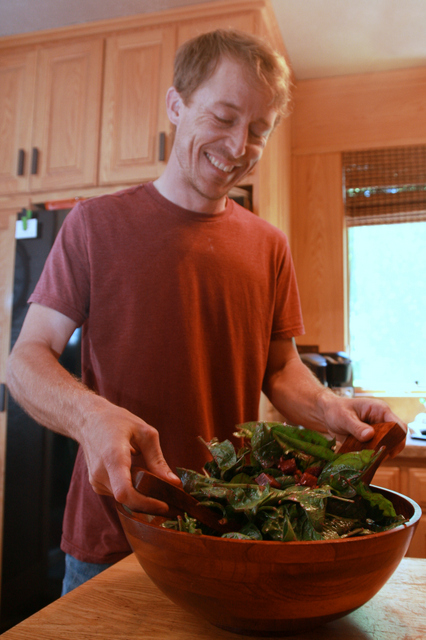
Very Veggie: Iowan’s Farm-Fresh Recipes Offer Guilt-Free Eating
For a guy who didn’t care for vegetables as a kid, Adam Nockels has come a long ways. Now he runs Iowa’s Raccoon Ridge Farm, which specializes in an array of naturally-grown produce.
“My foodie friends in college, including one who is a gardener, got me interested in fresh foods and new flavors,” said Nockels, who was born in Lake City but grew up on military bases before returning to the Lake City area.
Food production also appealed to Nockels, a U.S. Air Force veteran who used the G.I. Bill to attend Iowa State University, where he earned his biology degree in 2010. After completing an internship at Turtle Farm near Granger, where he learned about vegetable production and community supported agriculture (CSA), Nockels knew he wanted to work in production agriculture. When he proposed the idea of starting a farm on the land his family owns between Lake City and Auburn, his grandparents Dennis and Sheila Moulds liked the idea.
“My Grandma Sheila and my mom, Debby, have green thumbs,” said Nockels, who has 10 acres in Raccoon Ridge Farm, which includes 2.5 to 3 acres of vegetables grown with organic practices. “I also like working outdoors and growing healthy food for people.”
Nockels grows a wide variety of crops, including green beans, spinach, lettuce, radishes, strawberries, kale, herbs, squash, peas, potatoes, beets, heirloom tomatoes and more, which he sells at the Lake City Farmers Market and through his weekly CSA deliveries in Lake City, Rockwell City and Carroll. Nockels’ favorite heirloom tomato is the Cherokee Purple Tomato, a flavorful variety that was reportedly gifted to a farmer in Tennessee in the 1890s from Cherokee natives. “Nothing is better than an heirloom tomato,” Nockels said. “For me, it’s either slice, salt and go, or use the tomato in a BLT sandwich.”
Nockels’ weekly newsletters for CSA customers include a list of produce supplied that week, brief descriptions of the unique items in the box, tips for storing the produce, recipes and seasonal cooking tips such as how to roast chile peppers. Some of Nockels most popular items are his green beans. In 2015, the sandy, loamy soils of Raccoon Ridge Farm produced almost 450 pounds of green beans, so full-share holders received roughly 23 pounds of green beans each.
Nockels enjoys experimenting with new recipes, as well as relying on tried-and-true family recipes, to showcase the bounty of the harvest. “When good food is prepared properly, it tastes better. This is guilt-free eating.”
Savor more of Iowa and its food stories, history and more
Want more fun Iowa food stories and recipes? Sign up today for my blog updates and free e-newsletter, or click on the “Subscribe to newsletter” button at the top of my blog homepage.
You can also order my “Calhoun County” Iowa history book, postcards made from my favorite photos of rural Iowa and more at my online store. Thanks for visiting!

Roasted Beet Salad with Goat Cheese
1 / 4 cup balsamic vinegar
3 tablespoons shallots, thinly sliced
1 tablespoon honey
1/ 3 cup extra-virgin olive oil
Salt and freshly ground black pepper
6 medium beets, cooked and quartered
6 cups fresh greens (spinach, lettuce, arugula, etc.)
1 / 2 cup walnuts, toasted, coarsely chopped
3 ounces soft fresh goat cheese, coarsely crumbled
Line a baking sheet with tinfoil. Preheat oven to 450 degrees
Whisk the vinegar, shallots and honey in a medium bowl to blend. Gradually whisk in the olive oil. Season the vinaigrette to taste with salt and pepper. Toss the beets in a small bowl with enough dressing to coat. Place the beets on the prepared baking sheet, and roast until the beets are slightly caramelized, stirring occasionally, about 12 minutes. Set aside and cool.
Toss the greens and walnuts in a large bowl with enough vinaigrette to coat. Season the salad to taste with salt and pepper. Mound the salad atop four plates. Arrange beets around the salad. Sprinkle with goat cheese. Serve.
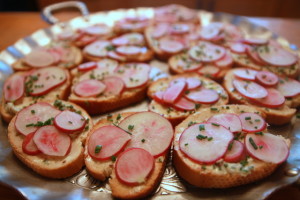
Radish Toast with Sesame-Ginger Butter
4 tablespoons butter, room temperature
3 tablespoons minced chives, divided
1 tablespoon toasted sesame seeds
3 / 4 teaspoon grated peeled fresh ginger
1 / 4 teaspoon Asian sesame oil
16 1 / 4-inch-thick baguette slices, lightly toasted
10 radishes, thinly sliced
Mix butter, 2 tablespoons chives, sesame seeds, ginger and sesame oil in small bowl; season with salt and pepper. Spread butter mixture over each bread slice. Top with radishes, overlapping slightly. Sprinkle with remaining chives.
Spinach Quiche
1 tablespoon butter
2 spring onions, minced
2 bunches spinach, thick stems removed and leaves roughly chopped
Coarse salt and ground pepper
4 ounces Gruyere or Swiss cheese, grated (about 1 cup)
1 frozen pie crust
4 large eggs
1 1 / 2 cups half-and-half
Dash of ground nutmeg
1 teaspoon salt
1 teaspoon pepper
Preheat oven to 350 degrees, with racks set in upper and lower thirds. In a large skillet, heat butter over medium. Add spring onions, and cook, stirring occasionally, until softened, 1 to 2 minutes. Add as much spinach to skillet as will fit; season with salt and pepper, and toss, adding more spinach as room becomes available, until wilted, 2 to 3 minutes.
Transfer spinach mixture to a colander. Press firmly with the back of a spoon to squeeze out as much liquid as possible. Sprinkle cheese onto crust. Spread spinach mixture over shredded cheese.
In a large bowl, whisk together eggs, half-and-half, nutmeg, 1 teaspoon salt and 1 teaspoon pepper. Pour egg mixture into crust.
Bake until center of quiche is just set, 55 to 60 minutes. Let quiche stand 15 minutes before serving.
Cover and refrigerate leftovers up to 1 day. Reheat at 350 degrees until warm in the center, 30 to 40 minutes.
Easy Kale Chips
Preheat oven to 350 degrees. Remove large central stem from kale leaves and tear into chip sized pieces. Drizzle with olive oil and add a sprinkle of salt or seasoned salt. Bake in the oven for 10-15 minutes until leaves edges are brown but not burnt.
Peas and New Potatoes
1 pound new potatoes
1 cup shelled peas
1 tablespoon butter
1 tablespoon flour
Salt and pepper to taste
1 cup milk or half & half
Bring a large pot of water to a boil over high heat. Boil potatoes for 15 to 20 minutes, until tender. Drain.
In a medium saucepan, bring 1 cup water to a boil. Simmer peas in boiling water for 6 to 7 minutes, or until tender (do not overcook). Drain.
Using the same saucepan, melt butter over medium heat. Stir in flour to make a thick paste; gradually whisk in milk, stirring constantly until slightly thickened. Season with salt and pepper to taste. Add potatoes and peas to the sauce; simmer for about 5 minutes, stirring often. Serve immediately.
Crisp Tuna-Cabbage Salad
One 5-ounce can tuna, drained
2 cups finely chopped green or red cabbage, from about 4 ounces or 1 / 4 of a small head of cabbage
1 tablespoon mayonnaise
3 tablespoons plain Greek yogurt
Salt and freshly ground black pepper
Shred the tuna with a fork and mix thoroughly with the cabbage. Stir in mayonnaise and yogurt. Add salt and pepper to taste. Eat immediately, or refrigerate for up to two days. Makes two 1-cup servings.
Basil Pesto
1-2 cups fresh basil leaves
2-4 cloves of garlic
3 / 4 cup good olive oil
1 / 2 cup grated Parmesan cheese
1 / 4 cup pine nuts or walnuts (opt.)
Put basil in blender or food processor. Add garlic, and blend, adding olive oil slowly. Add Parmesan and pine nuts. Blend all into a thick sauce.
This is good over any hot pastas. It can be also added to salad dressing, 1 tablespoon at a time, used as a spread for tomatoes, on crackers, etc. Pesto can also be frozen in small container for use later.
Green Bean and Pasta Salad
4 ounces penne pasta, uncooked (1 1/4 cups)
4 ounces green beans, halved crosswise (about 1 cup)
1 cup canned red or kidney beans, rinsed
1/4 cup chopped fresh flat-leaf parsley
2 tablespoons grated Parmesan (2 ounces)
2 tablespoons olive oil
2 tablespoons fresh lemon juice
Kosher salt and black pepper
Cook the pasta according to the package directions, adding the green beans during the last 3 minutes of cooking. Drain and run under cold water to cool.
Toss the cooled pasta and green beans with the red beans, parsley, Parmesan cheese, olive oil, lemon juice, 1 / 2 teaspoon kosher salt, and 1 / 4 teaspoon black pepper. Divide the salad between two containers and refrigerate for up to one day.
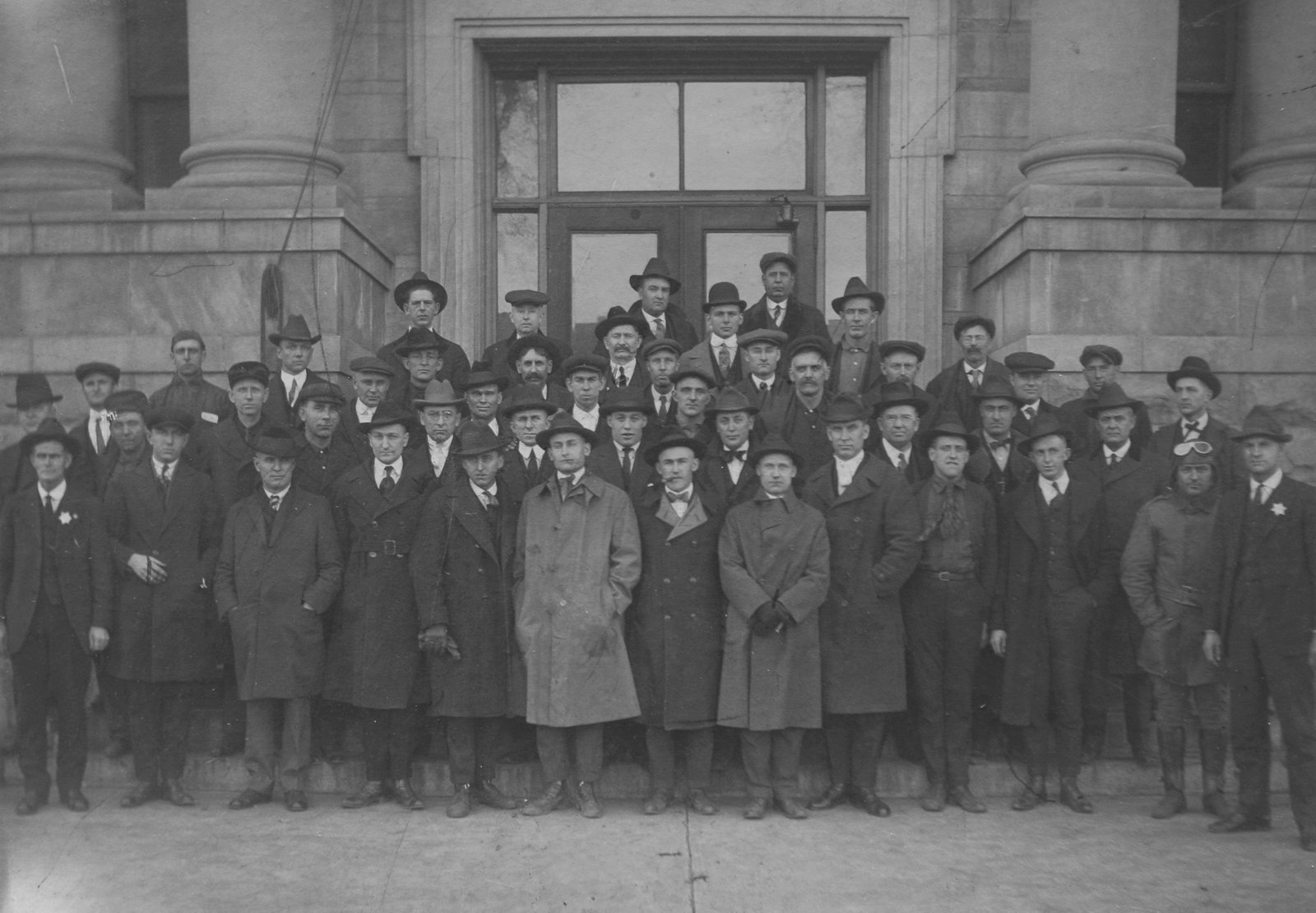
Iowa’s Vigilante Crime Fighters of the 1920s and 1930s
Who were these guys? It’s a question I couldn’t get out of my mind after I discovered a black-and-white image in the Calhoun County Museum in Rockwell City that showed a group of well-dressed men in front of the Calhoun County Courthouse. The only identification on the image, which appeared to be from the late 1920s or early 1930s, were the words “Calhoun County Vigilantes,” along with some long-forgotten names of men I suspect were mayors and other leaders in local towns around the county.
A recent trip to the fascinating “Ain’t Misbehavin:’ The World of the Gangster” exhibit at the Hoover Presidential Library and Museum helped me piece together some potential clues about the story behind this photo.
While bank robbers and swindlers are as old as the banking industry itself, crime sprees shifted into high gear during the early twentieth century. As early as 1912, the Iowa Bankers Association (IBA) decried the “epidemic” of bank burglaries sweeping the state. This proved to be only an inkling of what lay ahead, however. By 1920, burglaries and holdups had increased so dramatically that new protective measures had to be taken.

This 2016 display in the “Ain’t Misbehavin:’ The World of the Gangster” exhibit at the Hoover Presidential Library and Museum in West Branch, Iowa, explains more about vigilantes and the role of the Iowa Bankers Association.had increased so dramatically that new protective measures had to be taken.
Although the Iowa Bankers Association (IBA) had previously employed the services of the Pinkerton Detective Agency and the W. J. Burns Detective Agency, the IBA formed Vigilante Committees in the early 1920s to fight the crime wave. In 1921, IBA helped organize 99 county associations and a Vigilance Committee in nearly every city and town in the state to help protect Iowa’s banks.
Vigilantes attracted international attention
The system was a modern reincarnation of the vigilante groups who fought back against horse thieving and cattle rustling during the days of the pioneers. In Iowa, each Vigilance Committee consisted of at least four men in every town where there was a bank. Each committee member was appointed as a deputy sheriff by the county sheriff. In addition, the banks of each county subscribed to at least a $1,000 reward for the apprehension and conviction of bank burglars, plus smaller rewards for telephone operators who helped in the process.
Arrangements were later made with the U.S. War Department so officers in each of Iowa’s County Bankers Associations could purchase guns and ammunition for the members of their Vigilante Committees. The Vigilance Committees were prepared for—and frequently engaged in—gunfights with criminals. At one time, there were 4,303 vigilantes covering 881 banking towns in 84 Iowa counties. “The time of easy dough for the bank bandit has passed,” noted a financial publication that commented on the plan.
Thanks to this system, the bank theft crime wave that had swept Iowa was broken. While losses from bank burglaries totaled more than $225,000 in 1920-1921, more than 100 bank bandits were apprehended from 1920 to 1925. “The plan was such a success that rates for bank burglary and bank insurance in Iowa were dropped to $1 per thousand, while in other states the rates ranged from $4 per thousand in Missouri to $10 per thousand in Oklahoma,” noted Howard E. Bell in his book, “A History of the Iowa Bankers Association.”
Insurance companies across the United States quickly adopted the Iowa Vigilance Committee Plan. A 10 percent discount for both night burglary and daylight holdup insurance rates was automatically granted to banks in any county in the United States that maintained Vigilance Committees.
Iowa’s Vigilance Committee Plan continued to be of national interest for a number of years and generated coverage in a number of magazines and periodicals. As late as 1930, the IBA received an interview request from a publication in Paris, France, that wanted to feature the Vigilance Committee Plan.
IBA takes to the airwaves
Though the vigilantes helped curb crime in the 1920s and early 1930s, the IBA also initiated a low-wave police radio system to bolster its crime prevention efforts. While Des Moines radio station WHO had broadcast news of bank robberies (when requested by the IBA) as early as 1924, it became clear that a radio station devoted solely to police information must be established.
To connect local law enforcement officers with the Iowa Bureau of Criminal Investigation by radio, the IBA purchased a transmitter that was installed in February of 1932 in the organization’s headquarters in the Liberty Building in Des Moines. After the system was tested carefully, station KGHO began regular operations on May 15, 1933.
Later, four other radio stations in Storm Lake, Atlantic, Fairfield and Waterloo (subsequently moved to Cedar Falls) commenced operations to allowed prompt contact with county sheriffs’ offices throughout Iowa. While the IBA transferred the operation of its radio station in 1937 to the State of Iowa and the organization sold its radio equipment, the IBA’s leadership in radio communication helped initiate Iowa’s permanent, statewide police radio system.
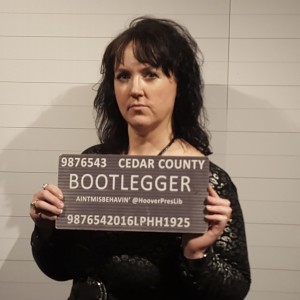
Couldn’t resist getting in on the action at the “Ain’t Misbehavin:’ The World of the Gangster” exhibit at the Hoover Presidential Library and Museum in West Branch, Iowa!
Although radio communication lessened the need for Vigilance Committees, the groups continued to function. The rewards that had been offered by various County Associations were rescinded around 1938, however, as the number of bank holdups and burglaries decreased substantially. As new state crime prevention agencies developed, the suggestion was made to abolish the Vigilance Committees, so banks would no longer have to assume the expense of maintaining the committees. Nevertheless, there were 216 vigilantes who remained active in a number of counties across Iowa as late as 1949.
Although the vigilantes and IBA radio stations are long gone, their legacy remains an intriguing part of Iowa history, including right here in Calhoun County.
Explore more rural Iowa history
Like what you’ve seen here? Sign up today for my blog updates and free e-newsletter, or click on the “Subscribe to newsletter” button at the top of my blog homepage.
Want to discover more stories and pictures that showcase the unique history of small-town and rural Iowa? Perhaps you’d like a taste of Iowa’s culture and favorite recipes. Check out my top-selling “Culinary History of Iowa” book from The History Press and “Calhoun County” book from Arcadia Publishing, and order your signed copies today.
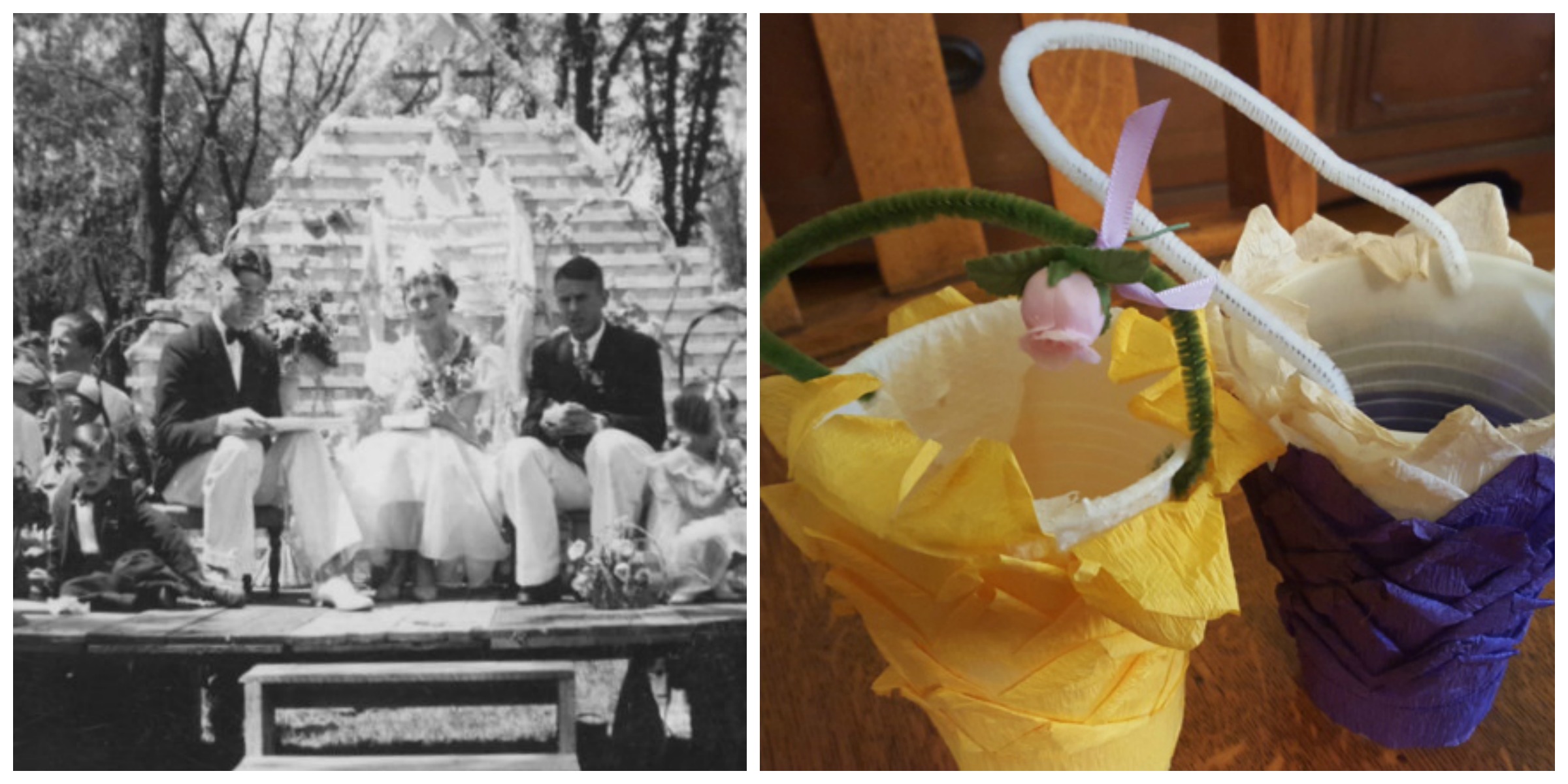
Mayday, Mayday—The Lost History of May Poles and May Baskets in Iowa
Remember the fun, colorful tradition of creating homemade May baskets? (I do.) If you’re a certain age, you may even remember dancing around the May pole. (I don’t). All were once beloved rites of spring here in Iowa and across America.
In many Midwestern communities, May Day celebrations were a highlight of the year. As I researched my book “Calhoun County,” which showcases the history of small-town and rural Iowa through the eyes of those who lived it, I came across a unique picture. Thelma Basler, a member of the senior class of 1935, was elected May Queen by the Lohrville High School student body. In addition to voting for the May Queen
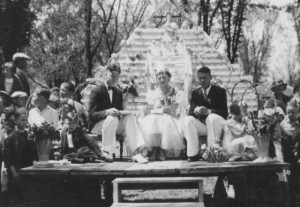
Lohrville High School May Queen, Thelma Basler, 1930s, Lohrville, Iowa
, students decorated the school flagpole in honor of May Day and delivered May baskets to friends.
While these May 1 customs have largely faded from American pop culture, they still endure in pockets of Iowa and beyond, where some of my friends’ children still enjoy making May baskets filled with treats. I started thinking—where did these May Day traditions come from? A little research hinted at something less wholesome than childhood craft projects and school celebrations.
Taming a raucous rite of spring
May pole dancing, for example, dates back to ancient pagan cultures in Europe. Each spring, people would erect a May pole, often of cedar or birch, and dance around it, typically weaving colorful ribbons around the pole as they went, to ensure a fruitful planting season.
An obvious phallic symbol, a May pole was strongly associated with fertility. After the European continent became Christianized, the more raucous elements of May Day celebrations were toned down, but the May pole dance and May baskets survived in a more G-rated form. These customs were carried to America, where they endured well into the twentieth century.
May Day memories from small-town Iowa
In my home town of Lake City, Iowa, Jolene Schleisman recalls weaving ribbons around a May pole in the gymnasium/lunchroom at Lincoln Elementary School in the 1960s. This spring ritual had ended by the time I attended Lincoln Elementary in the 1980s, although I did take square-dancing lessons in

Homemade May baskets created in Lake City, Iowa
music class, a tradition that has now gone the way of the May pole.
During my time at Lincoln Elementary, I did get to experience the joy of making May baskets filled with candies and popcorn to give to friends and family. In the 2015 article “A Forgotten Tradition: May Basket Day,” NPR explained the phenomenon this way:
“As the month of April rolled to an end, people would begin gathering flowers and candies and other goodies to put in May baskets to hang on the doors of friends, neighbors and loved ones on May 1. In some communities, hanging a May basket on someone’s door was a chance to express romantic interest. If a basket-hanger was espied by the recipient, the recipient would give chase and try to steal a kiss from the basket-hanger.”
In Lake City, homemade May baskets became a fundraiser for the ladies of the Presbyterian Church in the mid-twentieth century. Church members including Fanny Howell, principal of Lake City High School from 1928 to 1935, made May baskets out of small paper milk cartons (washed and sanitized with bleach). The ladies decorated each May basket with colorful crepe paper and attached pipe cleaners for handles.
The cheerful baskets were displayed in the front window of McIntyre Furniture store on Center Street, where the smaller baskets could be purchased for a penny apiece. Buyers could then fill the baskets with the treats of their choice and deliver them to friends around town.
Long gone are the penny May baskets, McIntyre Furniture, Fanny Howell and many of the traditions that once defined May 1 in communities across Iowa and beyond. In one respect, however, I’m glad that some major company has not rediscovered May Day, only to mar its simplicity with commercial baskets, cards and trinkets. There’s still something to be said for simplicity and tradition.
Savor more Iowa food history
Want more fun Iowa food stories and recipes? Sign up today for my blog updates and free e-newsletter, or click on the “Subscribe to newsletter” button at the top of my blog homepage.
Check out my top-selling “Culinary History of Iowa” book from The History Press, and order your signed copy today. You can also order my “Calhoun County” Iowa history book, postcards made from my favorite photos of rural Iowa and more at my online store. Thanks for visiting!
Savoring the Memories: Van’s Café Served Up Comfort Food for Six Decades
Auburn—There’s basic, small-town café food, and then there’s home-cooked café food that’s so good people come back for generations. That’s how it was at Van’s Café in Auburn.
While everyone seemed to have their favorite breakfast and lunch items at Van’s Café, the Smothered Hash Browns were always a best seller. Topped with sausage, onions, green peppers, mushrooms and cheese (along with two fried eggs on top, if desired), this perennially popular dish sold out during the last weekend in March before Van’s Café closed permanently after 61 years.
Some guests came for the first time to try classics like the Smothered Hash Browns, while long-time customers took the opportunity to joke with Richard Vanderheiden, owner. “Hey, Richard,” said one of the old timers when Vanderheiden stepped out of the kitchen. “I thought sure after all these years you’d learn how to cook before you quit!”
Vanderheiden takes it all in stride, just as he has for decades. The story of Van’s Café began in January 1954, when his parents, George and Rose Vanderheiden, moved their eight children (including Dorothy, Donald, Larry, Karen, Richard, Michael, Patrick and Mary) from Carroll to Auburn. They opened the Maidrite Café, which was located one lot over from where Van’s Café sits today on the west side of Highway 71.
The whole family pitched in waiting tables, washing dishes, taking out the trash and handling all the other duties required to run a restaurant. Those were the days when menu items like potato soup cost 30 cents, tuna salad was 35 cents and roast beef cost $1.15.
Vanderheiden was especially interested in the family business. “I started working there at age 10,” said Vanderheiden, 70, who enjoyed growing up in Auburn and remembers when the town boasted three grocery stores, a creamery, a hatchery, a drug store, two filling stations, a bank and a hardware store. “My mother was a very good cook, and I learned a lot from her.”
People could count on Van’s
In the spring of 1967, Vanderheiden came back from school to help his mother run the restaurant after his father became ill. After his father passed away, Vanderheiden took over the family business in 1972 and bought the building (which dates to 1893) where Van’s Café would be located for the next 43 years.
He operated Van’s Café each Monday through Saturday from 6 a.m. to 1:30 or 2 p.m. and Sundays from 8 a.m. to 1 p.m. “People knew they could count on Van’s being open,” said Vanderheiden, who served breakfast whenever the café was open.
Lorene Knobbe, who grew up in the area and now lives in Davenport, recalled eating at Van’s many times. She was sad to hear the café was closing for good. “My mom and dad loved that place and liked to go there on Sundays after church,” she said.
Other customers began reminiscing about the unforgettable meals they enjoyed atthis iconic, small-town café. Kurt McCaulley, a Lake City native who now lives in DeWitt, recalled how he and Larry McCaulley, Lynn Dial, Mike Carisch, Gregg Gass, Ronnie McCaulley and other guys who baled hay for Marj Richardson looked forward to lunch at Van’s Café. “We used to eat the hot-beef sandwiches for lunch, and lots of times we’d have two helpings.”
The café was also special to Luanne Redenius of Lake City, a former waitress who still recalls her first $5 tip. “My first job with a real paycheck was waitressing at Van’s during the early morning shift,” said Redenius, who was 17 at the time and had just graduated from Lake City High School in 1974. “Richard was a hard worker and kind man who always took time to answer my questions, no matter how busy things got—and it seemed like we were always busy.”
It’s not Auburn without Van’s Café
Through the years, Van’s Café has became known for a variety of comfort foods, including the signature Van’s Potato Soup (created by Rose Vanderheiden), meatloaf, goulash and famous 3-bean salad, which is often the most popular salad bar item.
While Vanderheiden kept a low profile most of the time, he always said “yes” when people walked in the door of his restaurant and asked, “Is this the famous Van’s Café?” He knew they probably heard the 1040 WHO Radio morning show when broadcaster Van Harden came to Auburn a few years ago to help Vanderheiden celebrate 40 years in business.
“That was a super day,” said Vanderheiden, who noted that nearly 600 customers showed up to be part of the unique event and enjoy a free breakfast.
Customers became more like friends at Van’s Café, which also became a part of many local family’s mealtime traditions. Jim Daisy of Lake City began bringing his son to Van’s Café for breakfast on Saturday mornings starting in the early 1980s. “I started doing this when my son was about four years old, and it was a good way for us to bond through the years,” Daisy said.
Along with locals like the Daisy family, Vanderheiden served customers from each of the 50 states and many foreign countries who wanted to experience an authentic, small-town Iowa café. “In this business, you succeed by knowing what your customers want and providing it consistently,” Vanderheiden said.
While some people offered to buy Van’s Café after hearing that Vanderheiden planned to retire at the end of March, Vanderheiden is more focused on relaxing and spending time with family. For Beth Buelt, a waitress from Auburn, working the final weekend at Van’s Café was a bittersweet experience. “I don’t know Auburn without Van’s Café,” she said.
Vanderheiden himself acknowledged it was hard at times to say goodbye after serving a final Sunday dinner of turkey, dressing, baked ham, dessert and coffee on March 29. “For decades we’ve been very blessed with wonderful employees and loyal customers,” said Vanderheiden, who offered a special thank you to the people of Lake City for their huge support through the years. “It has been a pleasure to serve everyone. I’ll miss the people, because it’s the people who make the café.”
Savor more Iowa food history
Want more fun Iowa food stories and recipes? Check out my top-selling “Culinary History of Iowa” book from The History Press, and order your signed copy today.
Soup and Small-Town Iowa Spirit
As the days grow colder, there’s just something comforting about a big old kettle of soup. Comfort food took on a whole new meaning this fall in Lake City when our community came together in October to raise money for the Alcox family.
Lake City’s fire chief, Mel Alcox, was partially paralyzed by a severe spinal cord injury sustained during an accident at his home in September. Volunteer fire fighters and friends hosted a fundraiser to help the Alcox family with medical expenses for Mel, who has been receiving treatment at a hospital in Des Moines—more than 100 miles away from Lake City.
On a cold, rainy Monday night, farmers took time out from harvest, business owners stopped by after work, and families gathered at the Lake City fire station to put money in the donation box and enjoy hot bowls of homemade soup, ham and cheese sandwiches, and an array of homemade bars—all prepared and donated by community members. Tables throughout the truck bays were filled as p
eople of all ages gathered to show their support for Mel and Phyllis. The kids also enjoyed signing the big, bright get-well cards to Mel, which were displayed in front of one of the fire trucks.
Remember the G-Words
I was happy to share a kettle of my homemade Beef and Barley Soup, which I modified slightly to fit the menu of three soups, including Beef Vegetable Soup, Chili and Chicken Noodle Soup. I’ve included my Beef and Barley Soup recipe below.
While this event raised thousands of dollars for the Alcox family (pretty impressive for a town of 1,800 people and other little towns nearby), it showed how small towns turn kindness and generosity into an art form. It’s also a reminder about how every day is a good day to think about the “G words” of generosity and gratitude.
I think Phyllis Alcox said it best in this Facebook post:
“There are times when we think that small towns don’t have all that we need, but when there is a tragic event in a family’s life, the support and concern for their well-being are overwhelming. And for this we are so very thankful.”
Savor more Iowa food history
Want more fun Iowa food stories and recipes? Check out my top-selling “Culinary History of Iowa” book from The History Press, and order your signed copy today.
Hearty Beef and Barley Soup
1 pound beef roast, cut into 1-inch cubes
1 tablespoon canola oil
3 cans (14-1/2 ounces each) beef broth
2 cups water
1 cup medium pearl barley
1 tablespoon seasoning salt
1/2 to 1 teaspoon freshly-ground black pepper
1 teaspoon thyme
1 teaspoon Italian seasoning, or 1 teaspoon bouquet garni seasoning
4 bay leaves
3 tablespoons dried parsley
Garlic (either 1 teaspoon dried, minced garlic, 4 cloves fresh garlic to taste or 1 teaspoon garlic salt)
1 can mushrooms (or use 1 to 2 cups fresh mushrooms)
1 can diced tomatoes, undrained
1 cup sliced carrots
1/2 cup chopped celery
1 cup chopped onion
1 cup frozen or canned corn
1 cup frozen green beans
1 cup potatoes, cubed
1/2 cup dry red wine
1 tablespoon BBQ sauce
1 tablespoon Worcestershire sauce
1 tablespoon steak sauce
1 teaspoon horseradish (don’t leave this out—it’s the secret ingredient that makes this soup memorable in a good way!)
In a pan, brown beef in oil; drain. Transfer meat to slow cooker. Add all remaining ingredients. Cook on low for 8 to 10 hours. Remove bay leaves before serving. Enjoy!
Darcy’s Top 10 Tips for Better Photos
You know a great photograph offers a priceless way to capture a moment in time. Did you consider that skilled photographers don’t take photos–they make them?
To improve my ability to create unforgettable photos, I’ve been taking various classes this summer from a professional photographer in central Iowa. Here are some top tips I’ve learned that may help you, too:
1. Stay focused. When photographing a person, always make sure his or her eyes are in focus. When photographing a group of people, especially groups of two to three rows of people, focus on the eyes of the person in the middle of the group towards the front.
2. Use a telephoto. Ideally, do not shoot at 50 mm. It “swells” your subject’s head and makes people look a litter wider than they really are. A better choice is 70 mm. Best yet? 120 to 200 mm. Also, I have found that the further back you are from the subject (it’s easy when using a telephoto lens), the more relaxed and comfortable the subject will be.
3. If it bends, bend it. (Have a person tilt their head slightly, or bend their arm by putting their hand on their hip, for example.)
4. Follow my hand. Rather than try to verbally direct the subject on how to turn (do you mean your left or my left?), hold up your hand vertically and move it the direction you want the subject to turn.
5. Hold that pose. Always position women at a 45-degree angle for the most flattering look. Men can be posed within the 45-degree range, left or right, with good results. Also, if your subjects are standing, have them shift their weight to their back foot for a more natural, relaxed look.
6. Avoid weird cuts. When composing the photo, don’t cut the image at the person’s joints, including their knees, wrists, elbows, or fingers, or the person will look like an amputee.
7. Mix it up. When shooting a group, don’t have the heads lined up in a row. Mix up the height for visual interest. Also, try to move heavier people towards the inside of the group, rather than having them on the end. This will create a more flattering picture.
8. Loosen up. To capture a more natural smile on your subjects, talk to them, and watch for facial expressions. Start with simple, basic questions about their hobby, etc. to get them to loosen up.
9. Adjust the flash. If you have a light-colored wall behind you, try tilting the flash at a 45-degree angle and pointing it towards that back wall. This will bounce a softer light towards your subject. It also helps minimize glare if he or she is wearing eye glasses.
10. Try some new gear. Consider an inexpensive, mini softbox to attach over your flash. (I bought my mini softbox off of Amazon.com.) The mini softbox works well if you’re shooting a subject outside around noon or mid-day, for example, when harsh shadows and harsh lighting can create challenges.
** Bonus tip: If you’re indoors, look for ways to position your subjects by a window that provides natural side lighting. This can help you create more flattering, better-lit shots without harsh, distracting shadows.
Iowa Barn Honors Pioneer Stock Farm
Seems like people just love stories about Iowa barns. While this article I wrote first appeared in Farm News in 2011, friends have asked me to reprint it on my blog. Here’s a glimpse of some remarkable Iowa farm history. Enjoy!
The Z.T. Dunham Pioneer Stock Farm barn near Dunlap has stood for well over a century as a monument to Crawford County’s early history and the golden era of agriculture. Built in 1870 by Z.T. (Zachary Taylor) Dunham, the son of the first white settler in Crawford County, the barn housed the working horses of the Dunham farm and for decades served as a landmark that guided travelers in western Iowa.
Bricks for the barn, which stands on a slope up from the Boyer River, came from a kiln on the Dunham farmstead northwest of the barn. The barn’s walls are three bricks thick on the upper level and four bricks thick on the lower level. Other native materials incorporated into the historic barn include a hand-hewn, 40-foot walnut beam in the lower level, a testimony to the existence of large trees that grew along the Boyer River.
At the time the barn was built, Z.T. Dunham farmed in partnership with his brother Sam to grow crops and raise cattle and hogs. The men’s father, Cornelius, who first came to theCrawford County area in 1852, was a well-known pork producer who had been known as “Hog Dunham” in Jackson County, Iowa, where Z.T. was born. Cornelius was credited with introducing hogs to western Iowa, according to the book, “The Z.T. Dunham Pioneer Stock Farm and Late 19th Century Agriculture,” published by the Dunlap Historical Society. Z.T., who raised Poland China hogs, was also interested in shorthorn cattle and started a cattle ranch about five miles west of his home.
The Dunham barn, whose joists are secured by pegs in a mortise-and-tenon construction, included a number of unique, labor-saving features. A trap door was built in the floor above each of the 10 horse stalls so that the farmer could drop hay or grain from the upper level to the mangers below. On the lower level, a cable-and-pulley system allowed a large manure bucket to be pulled along the rear of the stalls so the manure could be transported to a wagon outside the barn.
Generations of Dunham children enjoyed playing in the barn. Carrie Dunham, who was born in 1880, recalled walking the beams of the big barn with the boys. While this placed the children 20 to 30 feet from the floor, they swung from one platform to another on the hay rope. “I was careful not to look down and was always glad when my feet settled firmly on the other side,” said Carrie, whose memories are preserved in the book from the Dunlap Historical Society.
In 1992, Virginia Dunham, along with her children, donated the Z.T. Dunham Pioneer Stock Farm barn and an acre of land to the Dunlap Historical Society. It was Virginia’s wish that the barn would be restored and used as a museum and interpretive center. Because of Virginia’s efforts, the barn was placed on the National Register of Historic Places in 1993. The Dunlap Historical Society has showcased the barn in many fundraising efforts, including the sale of t-shirts, sweatshirts and commemorative Christmas ornaments.
“The barn is a very important part of our history, and it’s worth saving,” said Jane Davie with the Dunlap Historical Society.
Dedham’s Famous Bologna Turns 100: Kitt Family Offers a Taste of Iowa History
There’s hardly anything in Dedham that hasn’t changed dramatically since 1914, yet one tradition stays the same in this small Carroll County town—its famous bologna.
“This recipe has been handed down for 100 years,” said Dave Kitt, who owns Kitt’s Meat Processing in Dedham with his wife, Shawn. “Every meat locker has a specialty, and ours is Dedham bologna.”
It’s such an important part of the business, in fact, that the company’s slogan is the “Home of Dedham Bologna.” While no one quite remembers who created the original recipe a century ago, the smoky, beefy rings reflect the area’s German heritage.
Dedham bologna is predominantly beef, with some pork included in the natural casings, which are all tied by hand. The mild rings are hickory smoked for three and a half hours, resulting in a meaty celebration for the senses that’s fully cooked and ready to serve.
Local history books note that people saved their ration stamps during World War II to buy Dedham bologna, which was enjoyed at home and mailed to servicemen from the area. In years past, the downtown Dedham Meat Market would open up after Sunday Mass so families from the St. Joseph parish could purchase Dedham bologna for Sunday brunch or dinner.
As the locals have known for generations, there are countless ways to enjoy Dedham bologna, which can be eaten hot or cold. At Kitt’s Meat Processing, an electric skillet makes it simple to serve the crew a fast, hearty lunch of Dedham bologna fried with butter, potatoes and onions.
Some people like to include Dedham bologna on meat and cheese trays, while other people grill it, serve it with scrambled eggs, pair it with sauerkraut, use it as a pizza topping or chop it up like ham salad, Shawn Kitt said. “Customers come up with all kinds of creative ways to use Dedham bologna.”
Dedham native Helen Wiskus, 94, has been enjoying this unique culinary tradition all her life. “Dedham bologna has always been big here,” said Wiskus, who keeps about four rings of this “really tasty” bologna in her freezer at any one time. “When the family gets together, the Dedham bologna comes out.”
Family-owned since 1964
The Kitt family has been the keeper of the Dedham bologna tradition for 50 years. When Dave Kitt’s father, Leonard, was in his early 20s, he worked at the local meat locker for the previous owner, John Werner, Jr., for five years. In April of 1964, Leonard and his wife, Theresa, purchased the business, which offered a good way to support their seven sons.
This was an era when Iowa boasted more than 550 small meat processing plants, compared to less than 200 today. “Those were also the days when there were about three to five farm families in every section, and everyone raised livestock,” said Leonard Kitt, who will turn 77 soon and still helps out with meat cutting and hand-tying Dedham bologna.
While times have changed, Kitt’s Meat Processing continues to stay busy. From the fall deer hunting season through the Christmas holidays, the 11-member crew expands to 16 or 17 employees to handle all the work. Last December alone, customers purchased 1,300 rings of Dedham bologna, along with countless orders for homemade hot dogs, jerky, beef sticks, bratwurst and more.
Throughout the year, customers from Des Moines to Omaha and beyond stop by Kitt’s Meat Processing to select their favorite items. The Kitts also make home deliveries around town, sometimes placing the meat right in their customers’ freezers and running simple errands for older customers.
“It’s fun to meet all the people we serve,” said Shawn Kitt, who added that some of the locals also hang out at the locker on Saturday mornings. “These connections are what small towns are all about.”
Growing for the future
While the hours can be long, with days starting at 6:30 a.m. and lasting until 10 p.m. during the busiest times, the Kitts look forward to expanding their business. They are adding a 16-foot by 20-foot area to produce more specialty meats, including Dedham bologna.
“I like to cook and experiment with various spices to see what works,” said Dave Kitt, who took over the family business with his wife in January of 2002. “That’s what specialty meats are all about.”
While the business is currently considered a custom retail and custom slaughter facility, the Kitts are working towards getting an official retail status. This will allow the company to sell its products in grocery stores, farmers markets and other places.
The couple is especially interested in offering their meat products at the Downtown Farmers’ Market in Des Moines. “We appreciate people’s support for our local business,” said Shawn Kitt, who is glad the couple’s three children have had the chance to work at the locker as they’ve grown up. “We’re proud to keep the Dedham bologna tradition going.”
If you go
Kitt’s Meat Processing is open Monday through Friday from 8 a.m. to 5 p.m., and Saturday from 8 a. m. to noon. For more information, log onto www.kittsmeat.com.


